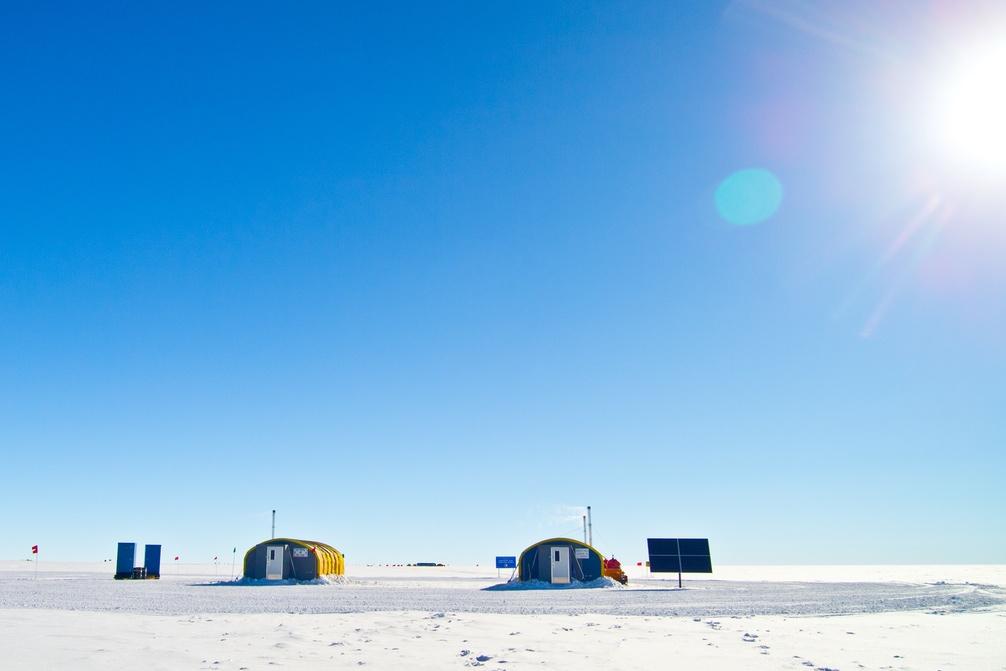South Pole’s latest tourist attraction
The view from there.
When Robert Falcon Scott arrived at the South Pole 100 years ago, he wrote in his diary: “Great God! This is an awful place.”
The desolate, flat expanse of white nothingness was not improved by the realization that Scott had been beaten to the spot by his rival.
Norway’s Roald Amundsen arrived on Dec. 14, 1911, a month ahead of Scott, who got there on Jan. 17.
Scott then died on his return trek.
The hordes of tourists — by South Pole standards — arriving this week at the same spot to mark the 100th anniversary of the race to the Pole will be met by a much different sight: the world’s southern-most gift shop.
Read more: Have you tried volcano-boarding yet?
Two temporary tents are being set up this week to give visitors a sense of history and an understanding of what happens at the US scientific station that now stands at the South Pole, known as the Amundsen-Scott South Pole Station.
Plus, a chance to buy souvenirs. What trip to the bottom of the Earth would be complete without a commemorative hat and T-shirt?
The South Pole was the final frontier of terrestrial exploration when Amundsen and Scott, a British Navy captain, set off on their race 100 years ago. Today it’s considered by many to be the final frontier in adventure travel.
About 300 visitors are expected over the course of the short summer season. Some will ski from the continent’s edge, while others will fly in.
Read more: Climate-change bad guys
For the 250 scientists and support staff who live at the station during the summer, the figures are huge.
“We expect that it’s going to be a little chaotic,” said Andrea Dixon, the South Pole’s tourism coordinator. “It will be crazy, but fun.”
The peak of the tourist boom will come on the anniversary of Amundsen’s arrival on Dec. 14, when over 100 visitors are expected, including a Norwegian delegation led by Prime Minister Jens Stoltenberg, Dixon said. Last year, 266 tourists dropped by the pole over the whole two-month summer season, December and January.
Summer visitors can expect temperatures in the -40 to -20 Farenheit range and a great deal of bustle at the station as everyone tries to take full advantage of the short summer to get their work done.
The decision by the National Science Foundation, which runs the US Antarctic Program, to set up the visitors’ center and gift shop was made in part to corral visitors in a spot that wouldn’t interfere with day-to-day life at the station, Dixon said. They will also be offered guided tours of the station.
The US station houses scientists as well as the support staff — cooks, cargo handlers, construction crews, etc. — who keep the station running. The scientists are there to take advantage of the South Pole’s unique position and use tools such as a neutrino detector buried 1.5 miles under the ice to study the nearly massless sub-atomic particles or a massive telescope that peers into the universe in search of dark matter. A skeleton crew of about 50 people stays on during the winter.
The visitors center and gift shop are both semi-circular tents with skylights and heaters. The computers and cash register inside will be powered by solar panels.
Visitors interested in a South Pole magnet or anniversary patch can pay only in US dollars, no credit cards or other currency.
One of the challenges of operating a gift shop at the South Pole is that the area is a time-zone free-for-all.
Think about it: all the world’s time zones converge on that little point. Since it’s light 24 hours a day in the summer, it doesn’t really matter what you call noon and what you call midnight.
The station runs on New Zealand time, since US personnel fly to the continent from Christchurch. But tour operators and arriving delegates tend to stick to their native time zones.
Dixon says she’ll open for business whenever needed. “I’m expecting I’ll be called in the middle of the night,” she said.
Annie Aggens, the director of polar expeditions for PolarExplorers, a guiding company in suburban Chicago, said her tour groups will be thrilled to have 24-hour access to the store and visitors center. PolarExplorers is bringing 30 people on six trips to the pole this year by both ski and plane who have shelled out between $40,000 and $65,000 each.
The trek there is the main activity, whether fully or partially powered by their own cross-country skis or making the trip by plane. Aside from the requisite photo ops, a trip to the visitors center and gift shop, and a tour of station, there’s not much else to do but gaze out at the plain of ice and marvel at how anyone managed the trip 100 years ago without Gor-Tex, GPS or a warm cup of tea awaiting them.
Every day, reporters and producers at The World are hard at work bringing you human-centered news from across the globe. But we can’t do it without you. We need your support to ensure we can continue this work for another year.
Make a gift today, and you’ll help us unlock a matching gift of $67,000!
